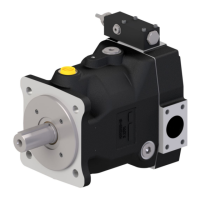6
Parker Hannifin Manufacturing Germany GmbH & Co. KG
Pump & Motor Division Europe
Chemnitz, Germany
Axial Piston Pump
Series PV, series 47 and higher
Bulletin MSG30-3245-INST/UK
Installation manual
2. Displacement adjustment
All axial piston pumps of the PV series are
equipped with an adjustable displacement limiter.
The servo piston stroke is limited at full displace-
ment by a screw, guided in the end cover plug
of the servo piston bore. The screw is protected
against unintentional adjustment by a self-sealing
lock nut (see figure on page 4).
Fluid content (general rule): stationary systems
3 to 4 times pump nominal flow, 1 times or even
smaller in mobile systems.
Filling of the system
Use only high quality mineral oil based fluids, like
HLP oils according to DIN 51524 part 2. For other
fluids (HFC, HFD, bio degradable or synthetic
fluids) please contact Parker and review the Hy-
draulic Fluids Information in Catalogue 2500/UK.
Operation viscosity should be 16 to 100 mm²/s,
optimum viscosity range is in the 20 to 40 mm²/s,
max. viscosity for short time up to 320 mm²/s.
Because of the possibly uncompatible ingredi-
ents fluids should not be mixed (separation of
fluid, reduction or loss of fluid properties).
Pay highest attention on cleanliness!
Fill system only via a filtration device. Use fil-
tration unit, when basic contamination of the
refill fluid exceeds class 10 according NAS 1638
(contamination level 21/19/16 according to
ISO 4406). Hydraulic fluid supplied in barrels
typically exceeds these contamination levels.
Filtration
Filtration is the most important factor to the op-
erational life of the hydraulic system. Statistical
analyses indicate, that contamination is by far
the most important reason for system or com-
ponent failure.
Use return line, pressure and/or bypass filtration.
Bypass filtration usually is most efficient. For
general purpose hydraulic systems with limited
requirements for operational life contamination
level 19/15 according to ISO 4406 should be
desired; corresponding filter rating: x = 25 µm
( b
25
≥75 ) according to ISO 4572.
Cleanliness level for systems with higher re-
quirements for operational life and functional
safety should be 18/16/13 according to ISO 4406;
corresponding filter rating x = 10 µm ( b
10
≥75 )
according to ISO 4572.
Use filter with indicator or electrical signal when
capacity limit is approached.
Suction filter should be avoided. Suction conditions
will be aected. Filter can be blocked and cause
cavitation and severe pump damage. When used, a
vacuum sensor with shut o function is mandatory.
Properly dimensioned breather rating ≤10 µm
should be used. Observe min. and max. fluid
level; consider exchange volume with cylinders
in the system.
Filling of pump case
Pump case must be filled via the drain port, to
ensure lubrication, sealing and smooth start up.
Start up
Check if all ports are properly connected ac-
cording to the specification, all connectors are
tightened and all adjustments are made.
Open suction valve (if installed)!
Switch system to free circulation or to lowest pres-
sure. Allow air bleeding for quick priming. Start
pump in tip mode operation until pump and all pipes
are filled and free from air bubbles. If pump does
not build up pressure, double check the installation.
Raise pressure setting only when all air is re-
moved. Let the pump work at reduced pressure for
5 – 10 min, check if all pipes and connections are
leak free and tight.
Observe reservoir: fluid level, built up of foam,
fluid temperature. When system is warmed up
first functional tests can be performed.
The factory setting of the displacement is accord-
ing to the nominal displacement of the pump.
An adjustment may only be made to a lower
displacement (turning screw in). An adjustment
to a higher than the nominal displacement can
destroy the pump.

